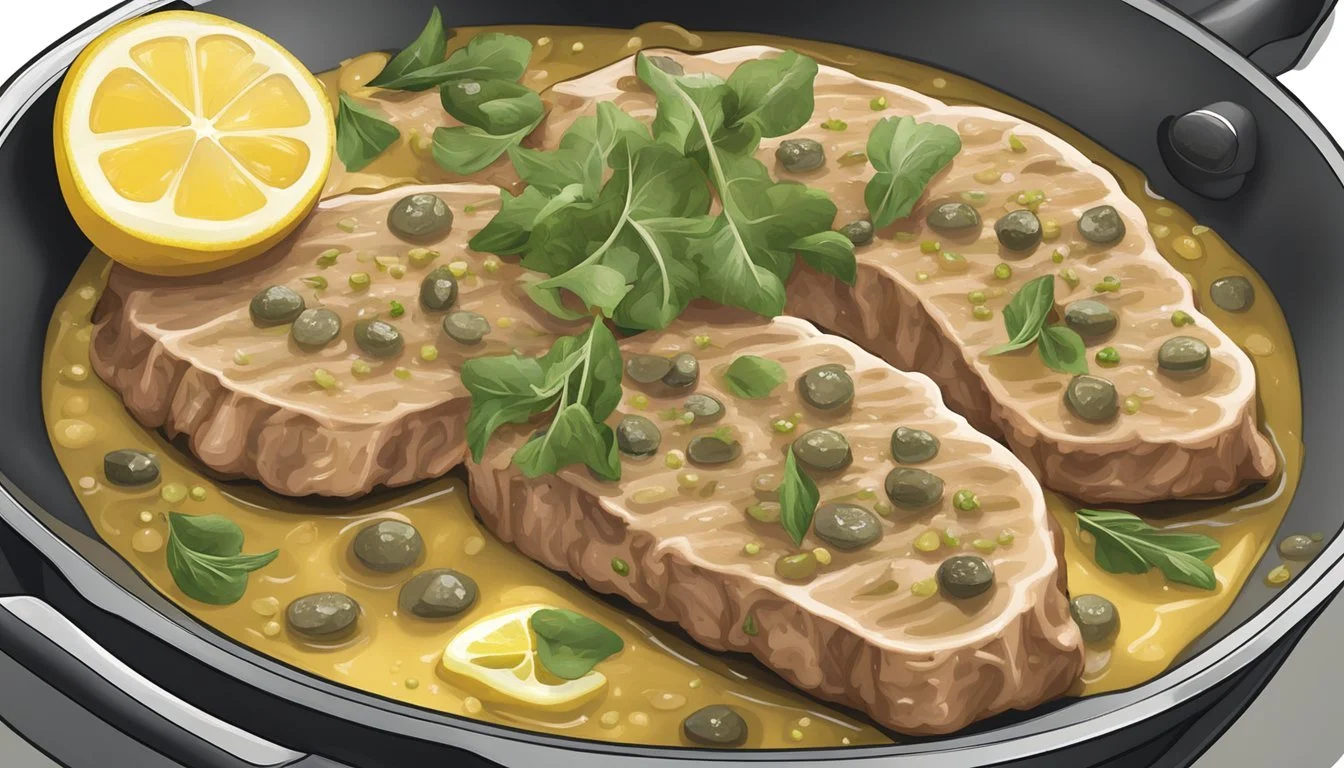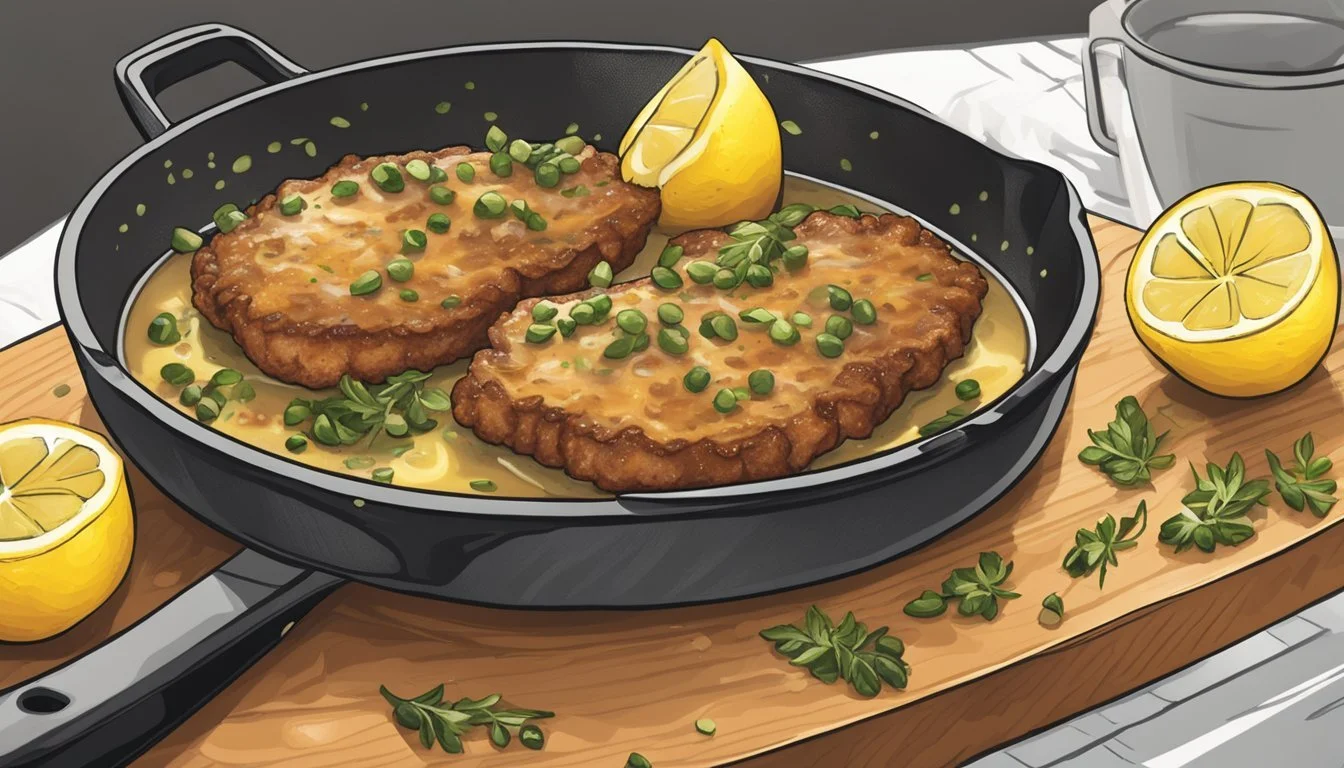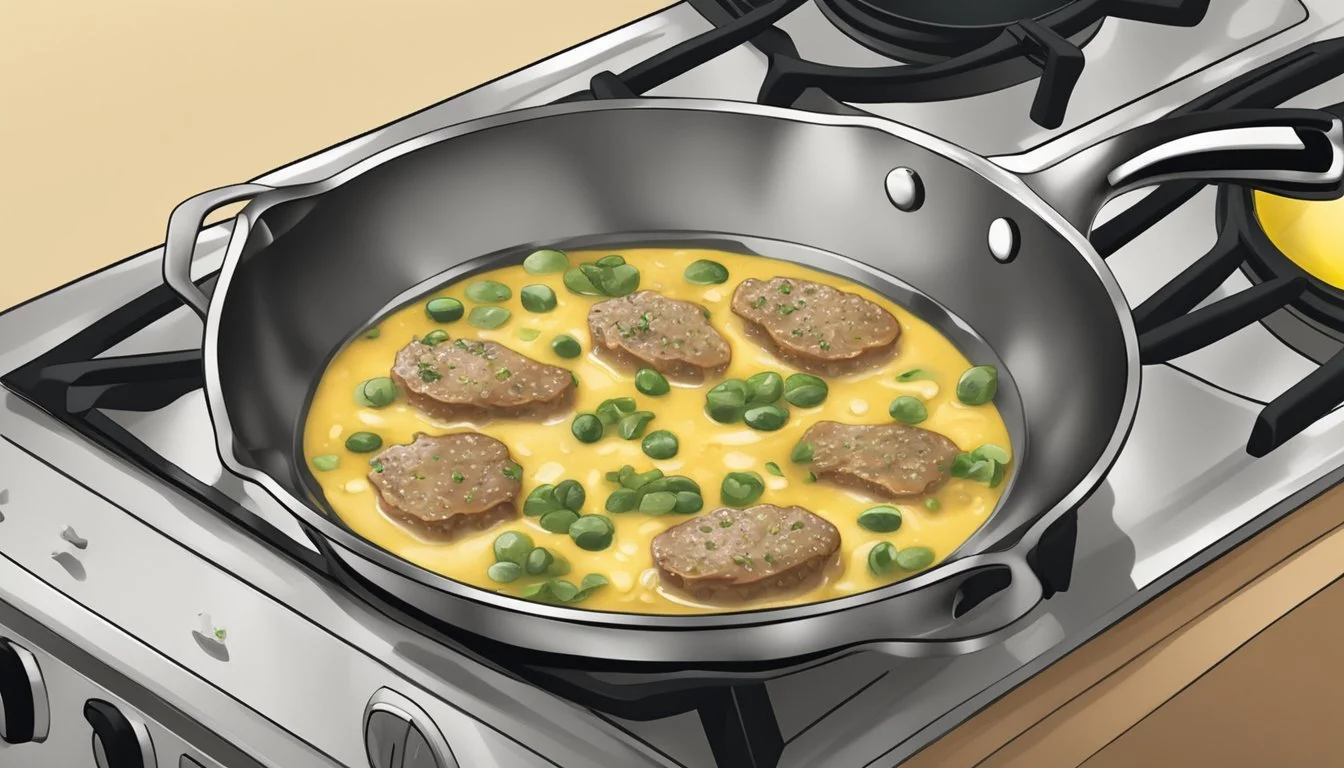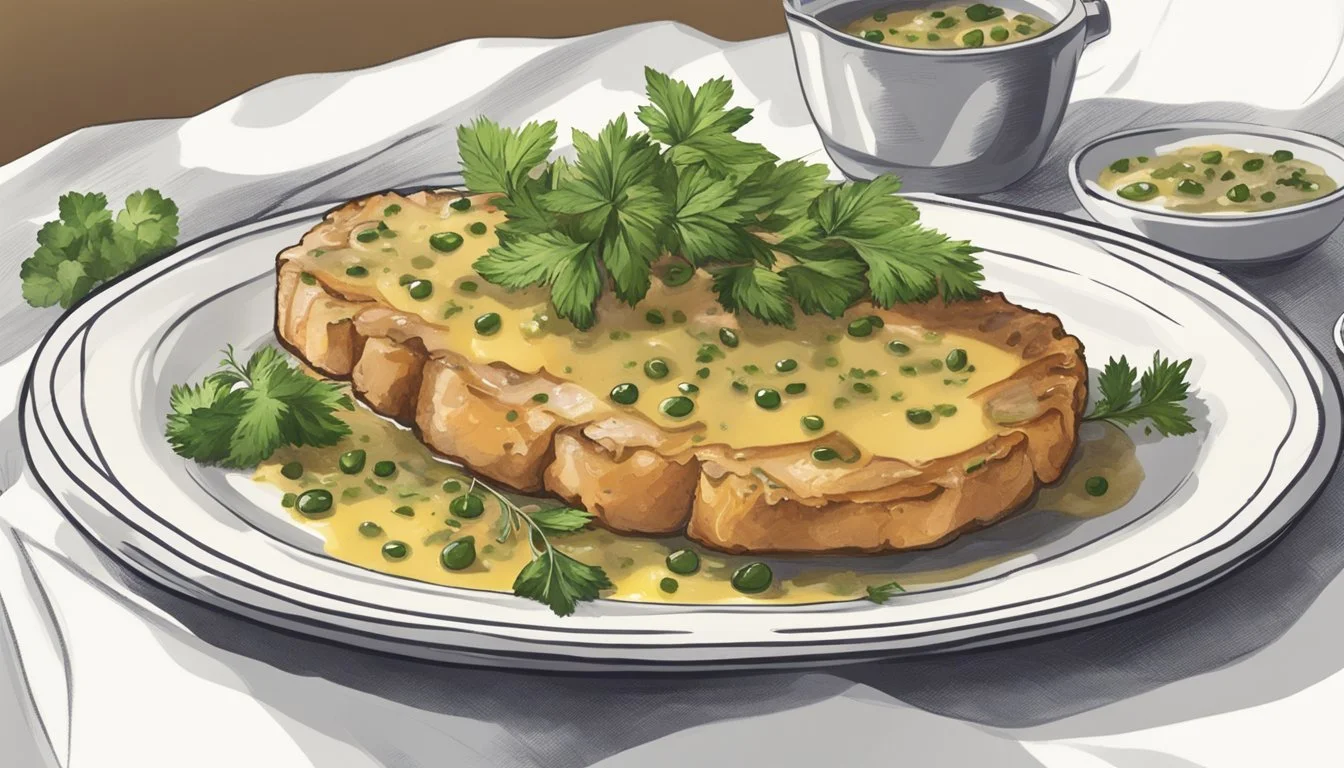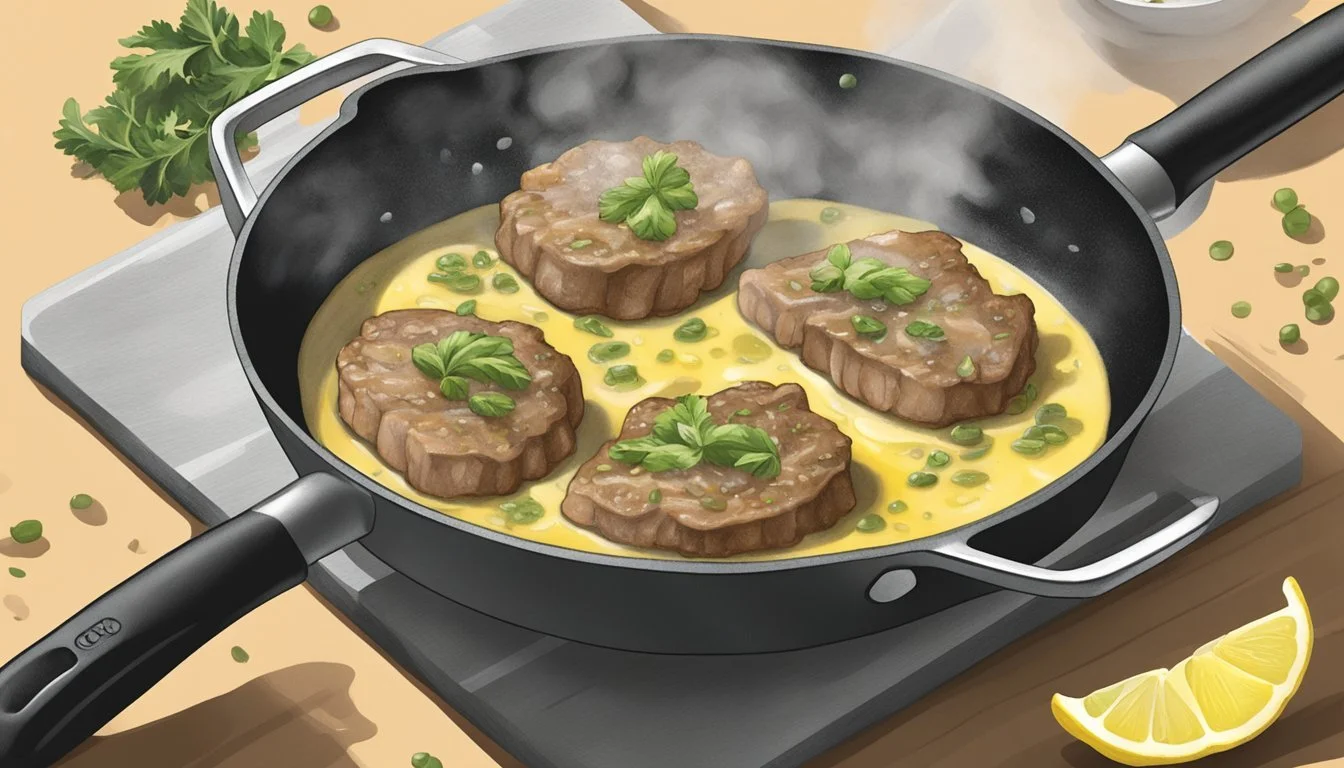Best Way to Reheat Veal Piccata to Preserve Tenderness and Flavor
Veal piccata, a classic Italian dish known for its tender slices of meat and tangy lemon caper sauce, is a staple in many fine dining establishments. Ensuring that leftovers maintain their quality and flavor can be a challenge, particularly when attempting to reheat without losing its signature tenderness and the vibrant taste of the sauce.
When reheating veal piccata, the key is to preserve the moisture of the meat and the integrity of the sauce. The process should gently warm the veal cutlets, allowing them to heat through without becoming tough, while also ensuring the lemon caper sauce remains vibrant and does not separate. This task requires careful attention to method and timing to achieve restaurant-quality servings from the comfort of one's kitchen.
Understanding Veal Piccata
Veal piccata is a classic Italian dish that combines tender veal cutlets with a vibrant lemon caper sauce. Recognized for its delicate flavors and easy preparation, it is a widely appreciated dish in both home kitchens and restaurants.
Traditional Ingredients
The foundation of veal piccata lies in its traditional ingredients. A typical recipe includes:
Veal: Thinly sliced veal cutlets pounded to ensure tenderness.
Flour: For dredging the veal, which provides a slight thickness to the sauce and a golden crust to the meat.
Butter and Olive Oil: A blend used for frying the veal, contributing to the rich flavor of the dish.
Lemon Juice: Freshly squeezed lemon juice is critical for the tangy characteristic of the piccata sauce.
Capers: (What wine goes well with capers?) These small, pickled flower buds add a burst of briny flavor that complements the lemon.
White Wine: Typically used to deglaze the pan and form the base of the sauce.
Nutritional Profile
In terms of nutritional profile, veal piccata can be broken down into calories, protein, and fat content. Here's a basic overview:
Nutrient Content (Approximate per serving) Calories 300-400 kcal Protein 20-30g Fat 10-20g
Veal is a good source of protein and is relatively low in fat compared to other meats. However, the addition of butter and olive oil increases the dish's total fat content, while the flour contributes to the carbohydrate component. It's important to note that variations in the recipe, such as the amount of oil used for frying or the incorporation of additional ingredients, will affect the final nutritional content.
Proper Storage of Veal Piccata
To maintain the quality and flavor of veal piccata leftovers, proper storage is essential. This ensures that when reheated, the meat remains tender and the tangy lemon caper sauce retains its character.
Refrigeration Techniques
Refrigerating veal piccata involves cooling the servings to a safe temperature before storing them in the refrigerator. The veal should be placed in an airtight container or tightly wrapped in plastic wrap or aluminum foil to prevent the exposure to air which can dry out the meat and sauce. It is crucial to:
Cool Down: Allow the veal piccata to cool to room temperature within two hours of cooking to reduce the risk of bacterial growth.
Storage: Place the veal piccata in a shallow container and cover it or seal it properly to minimize exposure to air.
Temperature: Keep the refrigerator temperature at or below 40°F (4°C). The veal should be consumed within three to four days for optimal quality.
Freezing and Thawing
For longer storage of veal piccata, freezing is a viable method. When freezing and thawing veal piccata, one must handle the dish carefully to preserve its taste and texture.
Freezing:
Cool the veal piccata thoroughly.
Use freezer-safe containers or bags, expelling as much air as possible.
Label the containers with the date, and consume within two to three months for the best quality.
Thawing:
Thaw the veal piccata in the refrigerator overnight. Avoid thawing at room temperature as it can lead to bacterial growth.
If in a hurry, use the microwave's defrost setting, but ensure immediate reheating and consumption after thawing.
Preparation for Reheating
Proper preparation is key to ensuring that veal piccata is reheated in a way that maintains its delicate tenderness and savory sauce. This section provides step-by-step reheating prep steps and important precautions to avoid overcooking the thin slices of veal.
Reheating Prep Steps
Meat Thickness: Begin by examining the veal piccata to ensure that the slices are pounded flat. Even thickness contributes to even reheating.
Room Temperature: Allow the veal piccata to sit at room temperature for about 15 minutes before reheating. This step reduces the thermal shock when reheating and promotes even warming.
Moisture Control: Slightly dampen a paper towel with water and lightly place it over the veal piccata. The added moisture aids in keeping the meat tender.
Precautions to Avoid Overcooking
Heat Settings: The heat should be medium to low, whether you are reheating in a microwave, on a stovetop, or in an oven. High heat can quickly overcook the veal, making it tough.
Use of Fats: If using a pan, a combination of butter and olive oil can help in achieving a golden brown finish while keeping the meat moist. Avoid using excessive amounts, which can cause the veal to become greasy.
Monitoring Closely: Keep an eye on the veal piccata as it reheats. Due to its thin nature, it requires just a short amount of heating time. It's done as soon as it reaches the desired internal temperature of 165°F (74°C).
Reheating Methods
Reheating veal piccata properly is crucial to maintain its tender meat and the characteristic taste of its buttery lemon caper sauce. The following techniques focus on achieving a golden-brown finish while preserving the integrity of the dish.
Stovetop Technique
To reheat veal piccata on the stovetop, one should gently warm the meat in a skillet to avoid overcooking. Begin by:
Heating a skillet on medium heat.
Adding a small amount of butter or oil to reintroduce moisture.
Gently place the veal in the pan, warming it thoroughly, and drizzle it with the preserved pan sauce for an enhanced flavor. Stirring occasionally helps to warm the dish evenly while maintaining the delicate browning of the meat.
Oven Method
The oven method is well-suited for evenly reheating larger quantities. To prevent drying out, one should:
Preheat the oven to a moderate temperature, around 350°F (175°C).
Place the veal piccata in an ovenproof dish, and cover it with foil to trap moisture.
Allow the dish to warm through for a sufficient time, typically 10-15 minutes. This slow reheating allows the caper sauce to infuse back into the meat, retaining its tender consistency.
Microwave Tips
While not ideal, using a microwave can be expedient. To reheat veal piccata in the microwave:
Transfer the veal and sauce to a microwave-safe dish.
Cover with a microwave-safe lid or vented plastic wrap to keep the meat moist.
Microwave on a lower power setting in short intervals, checking regularly to prevent the meat from becoming tough and the sauce from overheating. The goal is a gentle warming that keeps the veal piccata moist and flavorful.
Serving Suggestions
The elegance of veal piccata makes it an ideal choice for an upscale dinner, and selecting the right accompaniments and wine pairings is crucial to enhance its delicate flavors.
Accompaniments
Veal piccata, with its succulent meat and zestful lemon caper sauce, pairs wonderfully with a variety of side dishes. For a classic Italian serving, angel hair pasta is a top choice; it complements the tender veal without overshadowing the dish's signature sauce. Another excellent option is mashed potatoes, which provide a creamy texture that contrasts the piccata's tanginess. For a healthier and lighter side, steamed or sautéed green beans add a crisp freshness to round out the meal.
Wine Pairings
Choosing the right wine to serve with veal piccata can elevate the dining experience. A Pinot Grigio or Sauvignon Blanc are perfect matches for this dish, as their crisp acidity balances the lushness of the sauce. Alternatively, a dry white wine can complement the tangy lemon and capers without overpowering them. For those who prefer a richer wine, a lightly oaked Chardonnay harmonizes well, or a Marsala wine can add a touch of sweetness and complexity to the meal.
Alternative Uses of Leftover Veal Piccata
Leftover veal piccata can serve as an excellent base for a variety of creative dishes, ensuring that the tender meat and tangy sauce are enjoyed to their fullest. These leftovers can be transformed into entirely new meals or contribute rich flavors to homemade stocks.
Creating New Meals
One can easily repurpose leftover veal piccata into new and satisfying dishes. Below are two specific suggestions:
Veal Piccata Meatballs: Diced veal piccata can be mixed with breadcrumbs, egg, and parsley, then rolled into meatballs. They can be baked or pan-fried, offering a twist on traditional meatballs, featuring the unique lemon caper flavors.
Veal Piccata Fried Rice: Stir-fried rice with vegetables, eggs, and chunks of veal piccata can create a fusion dish. The veal adds a rich, savory element to the rice, making for a comforting meal.
Homemade Stock
Leftover veal piccata also serves as an excellent starting point for a flavorful stock, which can be used in various soups and sauces. Here's how one can utilize the leftovers:
Veal Piccata Stock: Combine the veal remnants with water, onions, carrots, and celery. Simmer the mixture, allowing the essence of the piccata to infuse the liquid.
Enriched Chicken or Beef Stock: Blend in pieces of the leftover veal piccata to a basic chicken or beef stock. A splash of the cooking wine from the piccata elevates the stock, adding a layer of complexity.
By incorporating leftover veal piccata into these alternative dishes, not only does one minimize food waste, but also enjoys the veal's versatility and rich flavor profile.
Special Diet Adaptations
When reheating veal piccata for special diets, it's essential to keep in mind the original ingredients that might need to be substituted. Adapting veal piccata to suit gluten-free and low-calorie dietary requirements can maintain the dish's integrity while ensuring it complies with individual dietary needs.
Gluten-Free Variations
To adapt veal piccata for a gluten-free diet, traditionally used all-purpose flour for dredging can be replaced with a gluten-free alternative. Here are specific modifications:
Dredging the Veal: Swap all-purpose flour with a gluten-free flour mix or almond flour for breading the veal cutlets.
Thickening the Sauce: Use cornstarch or arrowroot powder instead of flour to thicken the piccata sauce.
Ingredients:
Gluten-free flour mix or almond flour
Cornstarch or arrowroot powder
Adhering to these substitutes will ensure the veal piccata remains gluten-free without compromising the dish’s texture or flavor.
Low-Calorie Options
For those monitoring their calorie intake, veal piccata can be altered to reduce the overall calorie content:
Cooking Oil: Use a light spray of olive oil or grapeseed oil as opposed to traditional methods that may call for more generous amounts.
Sauce Preparation: Avoid using butter or reduce the quantity significantly, and consider incorporating low-sodium chicken broth to thin out the sauce while adding flavor.
Preparation Tips:
Lightly spray the pan with olive oil or grapeseed oil instead of using larger amounts.
Reduce the use of butter and opt for low-sodium broth to maintain flavor and moisture.
Implementing these changes helps lower the calorie content of the dish while still enjoying the savory and citrus-infused flavors of veal piccata.
Final Tips for Best Results
When reheating veal piccata, one should take care to preserve the dish's signature tenderness and the robust flavor of its lemon caper sauce. These final tips focus on maintaining the dish at its optimal taste and ensuring that it remains safe to consume.
Maintaining Flavor and Texture
To retain the delicate flavor and texture of veal piccata, gentle reheating is essential. The veal should be moistened with a small amount of broth, and if available, a touch of the original lemon sauce can be drizzled over the meat to help restore its zesty flavor. Butter can also be added to enhance richness. Here are the steps to follow:
Temperature: Reheat the veal in a skillet over medium heat.
Butter: Introduce butter to the pan to keep the veal succulent.
Broth: Add broth sparingly for moisture.
Lemon Sauce & Capers: Incorporate a bit of the lemon and caper sauce back into the pan, adjusting the seasoning if necessary.
Safety Considerations
Food safety is paramount when reheating any dish, especially when it involves meat like veal. The veal piccata should reach an internal temperature of 165°F (74°C) to ensure it is safe for consumption. Use the following guidelines:
Temperature Check: Use a food thermometer to verify the internal temperature of the veal.
Reheating Time: Avoid overcooking by reheating only until the suggested temperature is reached.
Consumption: Serve immediately after reheating to maintain quality and prevent the growth of bacteria.
By following these practices, veal piccata can be reheated successfully, providing a dish that is both safe to eat and delightful in taste.

